020 - Getting Chemicals Into Trees Without Spraying
Chemicals are applied to trees for many reasons. Insecticides repel or kill damaging insects, fungicides treat or prevent fungal diseases, nutrients and plant growth regulators affect growth, and herbicides kill trees or prevent sprouting after tree removal. Spraying is the most typical way to apply these chemicals. It is fast, uses readily available equipment, and is understood. The down side of spraying is that much of the chemical being applied is wasted, either to drift, run off, or because it can not be applied precisely to where it is needed in the tree. Also, in many cases the chemical is more effective when placed inside the tree, and this is difficult with spraying.
There are alternative methods of applying chemicals to trees that can be more efficient and targeted. These methods include:
- Trunk implantation
- Trunk injection
- Soil injection/drenching
- Trunk basal spray
Tree Stem/Trunk Anatomy

Cross Section of Trunk Edge with Vascular System Tissues
Older tree stems (trunks, branches, twigs, and even woody roots) have (from outside to inside) outer bark or phellem that is mostly dead corky tissue, cork cambium or phellogen that makes cork to thicken the outer bark, phloem that conducts food through the tree from where it is stored or made to where it is being used (all of these tissues together make up the bark), vascular cambium that divides rapidly to make new phloem and xylem cells, and xylem or wood. Xylem includes an outer layer called the sapwood that conducts mostly water and minerals from the roots to the canopy, and an inner layer called the heartwood that is aged sapwood that has died and has lost its ability to conduct water but still adds strength.
The phloem and the xylem consist of mostly vertical tubes of various sizes, but also have some bundles of tubes called rays that are oriented radially – they extend from the center portion of the tree outward through the sapwood and cambium to the phloem. Rays can be of various sizes. The largest rays tend to extend from the deepest, largest bark fissures, and there is relatively little outer bark covering the outer ends of those rays. This may be important for chemical uptake.
Most movement of chemicals applied by the methods described below takes place in the sapwood in both the vertical tubes and the rays. It is possible and seems likely that some chemical movement may also take place in the phloem but this has not been documented.
The following are descriptions of the different methods used to get chemicals into trees without spraying (with one exception).
Trunk Implantation/Injection
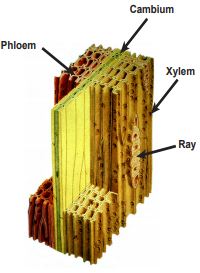
Conifer Stem Tissues
Trunk injection/implantation works by placing water soluble chemicals at or inside the cambium. The chemicals then move into and through the tree mainly in the xylem sap. The trick is to get the chemical into the right part of the tree, at the right time of year, in the right concentration. Injection and implantation tend to be good methods for treating piercing-sucking insects like aphids and adelgids. This is because water evaporation from the leaves (transpiration) pulls water up from the soil through the vascular tissue in the stem (the transpiration stream) where the chemical is applied.
Borers and bark beetles can be killed if chemical location and timing are just right, but that can be difficult. Ideally the chemical will accumulate in the vicinity of the borer or bark beetle. However, it is likely that much of the chemical meant for an insect feeding in the woody xylem will not affect it as it travels up to the leaves. Chemicals that are very water soluble, like metasystox-R, when applied in this way tend not to be available in the transpiration stream for very long because they are quickly taken up and moved. Some newer chemical formulations, like imidacloprid, extend their time of effectiveness by being less soluble so they are taken up over a longer period of time.
Pressure vs. No Pressure – Trunk injection involves introducing liquid chemicals under no pressure or lowto high-pressure (implants contain solid material and therefore no pressure is involved). Pressure can be useful. Introducing liquid under pressure can cut the time it takes to treat a tree because pressure speeds uptake. Less water is moving through a tree on a cloudy, cool day than on a hot, sunny day, so movement of a chemical into and through the transpiration stream slows. Also some tree species naturally have slower uptake, so these species are helped by the use of pressure. Slow take-up means that any chemical or apparatus left on the tree during treatment (chemical containers, tubing, tees, etc.) may be there for a long time, increasing risk of chemical exposure and vandalism.
A drawback of using pressure is the possibility of a bubble or embolism forming under the bark at high pressure. Bark can separate in the cambial area as chemicals are injected. This creates a reservoir of chemical that can be slowly taken up over time, but the entire area of that bubble should be considered a wound. Cells are split apart and killed to create that bubble. There also is a possibility of a leak or blow-back when chemicals are injected at high pressure. Some systems require the use of a rubber septum or seal at the point of the injection to minimize leakage. Finally, high pressure injection systems are complicated and expensive, and are not generally available to non-experts.
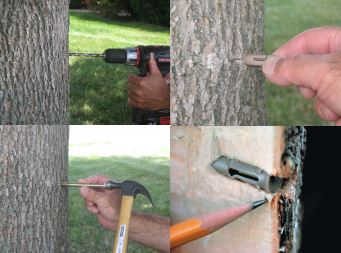
Implant Installation. Medicap
Implantation – The main form of implant available for tree use is a gelatin coated capsule that contains the chemical to be used. The capsule is contained in a plastic structure to protect it as it is inserted into the tree. The implant is inserted into a 1/4” to 3/8” diameter hole drilled in the trunk into the outer xylem or sapwood, just inside the cambium. Water from the transpiration stream seeps into holes in the plastic container, dissolves the gelatin, and the target chemical is taken up in the water and moved. The implant is left in the tree and is eventually covered by callus or woundwood. Several implants are used per tree and they generally are placed low on the trunk within the root flare. Typically one implant is used one for every four inches of trunk circumference measured at breast height (4.5 feet above ground). It is best to use a very sharp drill bit for any method where a hole is drilled because the xylem tubes are cut cleanly which makes uptake easier. Brad-point bits cut cleaner holes than typical twist bits.
Acecaps and Medicaps are the only implant brands currently available (Treerx). Chemicals used with these implants include acephate (Orthene) insecticide and various mineral nutrients (fertilizers). Material cost (2011) for a 14” diameter tree (10 implants) would be about $15. These implants have the advantage of being inexpensive, are usable by non-experts, are available through many retail nurseries and distributors, and are easily installed. The main disadvantage is that the holes are fairly large.

No Pressure System Using Container and Tubing for Iron Chlorosis Treatment
Injection – Trunk injection usually is more involved than implantation. Liquid chemicals are injected into the stem through various types of holes and devices. A simple system that is no longer available was used for applying iron to treat iron chlorosis. Pre-measured ferric ammonium citrate dissolved in water was squeezed from small vials into 1/8” diameter holes drilled low on the trunk. This system was inexpensive and simple. Though the product no longer is sold, similar systems may be developed in the future.
A similar type of no-pressure injection system uses holes drilled in the trunk and a system of tubing and barbed plastic fittings to drain liquid chemicals into the trunk from a container hung above. The only pressure in the system is from gravity. The material moves into the holes as it is taken up and, depending on the speed of uptake, this movement can be slow or fairly fast. An example of this kind of system is Medi-ject for treating iron chlorosis. Systems like this seem to be losing favor, possibly because their lack of pressure can make uptake slow. Avoid systems that require large holes (greater than 1/4”). Systems have been available that required only 1/8” holes.
Low pressure systems are available that can speed uptake but avoid embolisms. One of the best known is the Mauget system, which uses plastic capsules that are pressurized by depressing a plunger that locks in place. The capsule then is pressed onto a tube that is already inserted into the tree, breaking a seal in the capsule and releasing the pressurized chemical. Chemicals available through Mauget include antibiotics, abamectin, azadirachtin, bidrin, imidacloprid, metasystox-R, debacarb, phosphorous acid, tebuconazole. Material cost to treat a 14” diameter tree with imidacloprid is about $34. Other systems that use pressurized capsules with a similar array of chemicals include Tree Tech Microinjection Systems, and Rainbow Treecare’s M3 Infuser. These systems require fairly small drilled holes (1/8” to 3/16”), are fairly simple to use, and are slower than high pressure systems.
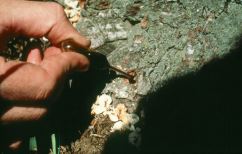 Old No-Pressure System for Treating Iron Chlorosis
Old No-Pressure System for Treating Iron Chlorosis
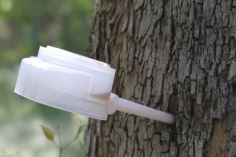 Pressurized Capsule Injection System. Mauget
Pressurized Capsule Injection System. Mauget
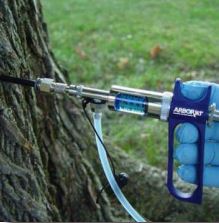 Drilled Hole Injector. Moore Tree Care
Drilled Hole Injector. Moore Tree Care
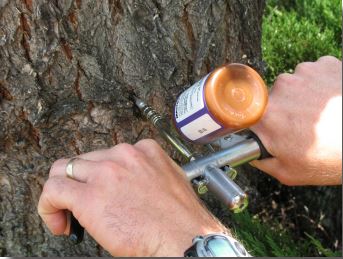 Injection System Without Drilled Holes
Injection System Without Drilled Holes
Higher pressure systems are available that inject chemicals using either a syringe or tubing, tees, and a chemical reservoir designed to be under pressure (pressures in these systems have not been tested in Utah, but Mauget and similar capsules seem to be lower pressure). These include Arborjet’s Tree I.V. system that uses tees and tubing and delivers high volumes of chemicals from a pressurized reservoir, and their QuikJet system that applies small chemical volumes with a syringe.
Equipment costs for these systems can be high ($1,300 for a deluxe kit from Arborjet in 2011) and the systems are fairly complex. Material costs to treat a 14” diameter tree with imidacloprid is about $17. Rainbow Treecare also has pressurized tubing and reservoir systems. Chemicals available for Arborjet’s and Rainbow’s pressurized systems include acephate, azadirachtin, antibiotics, abamectin, emamectin benzoate, imidacloprid, propiconazole, phosphorous acid, thiabendazole, and plant growth regulators.
ArborSystems’ Wedgle injection system doesn’t use drilled holes but relies on injection through a seal with a syringe and specially designed needle. It is fairly fast because of the pressure created by the syringe. Equipment and methods for this system are fairly complex and equipment cost is relatively high. No holes are drilled, but bubbles or embolisms can occur. ArborSystems’ instructions encourage use of the system when bark is loose and flexible so a bubble is formed to contain the chemical after injection. Chemicals available include abamectin, imidacloprid, phosphorous acid, propiconazole, and plant growth regulators.
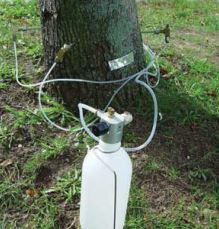
Pressurized Reservoir and Tubing System. Moore Tree Care
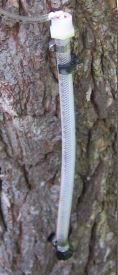
Modified STIT Tube. Medi-Ject
Pines and other resinous conifers produce resin when their living tissues are pierced and this resin will block chemical uptake from many injection systems. To overcome this Helson et al. (2001) devised a system called systemic tree injection tubes (STITs). The STITs consisted of 2 to 3 foot long pieces of 0.4 inch inside diameter plastic (Nalgene) tubing connected at one end to a maple sap spile and at the other end to a tubeless tire valve stem held in place with hose clamps, or some other valve or seal. The spile was pushed into a 1/3 inch diameter hole drilled fairly deeply (1-1/2 inches) into the sapwood at a slight downward angle. The chemical was placed in the upright tube, the valve stem was inserted, and clamp tightened, and the tube was pressurized through the stem with a bicycle pump to 40 psi. In their study they used two STITs inserted on opposite sides of the trunk at ground level. This system worked for treating Scotch pines (Pinus sylvestris) for pine wood nematode (Bursaphelenchus xylophilus) using abamectin (Avid). Commercial versions of the STIT system are available from Rainbow Treecare and Mediject.
That STIT study also used ArborSystems’ Wedgle injector for conifers and found it to be ineffective because of chemical leakage from bark crevices. ArborSystems, however, has a different tip they use for injecting resinous conifers called the Portle that is said to reduce leakage and get more chemical into the tree.
There are probably more injection systems available that are not included here, but this is a fairly complete overview of the different types of systems.
Advantages of trunk injection methods include use of a low chemical volume, relatively simple equipment in some cases, it can be done in windy or rainy weather, and there is little non-target organism exposure. Disadvantages include the creation of wounds by drilling holes or by embolisms, coverage can be spotty throughout the crown, and treating every year would be risky.
Soil Injection/Drench
Soil injection or drench methods involve placing chemicals in liquid form near the roots in the soil for root uptake. As with the other methods, the chemicals must be water soluble. Chemicals should be applied to moist but not saturated soil. Chemical application timing varies depending on the chemical and the pest. This is used for application of imidacloprid, dinotefuran (Safari), and some growth regulators. The high pressure equipment needed for injection would be expensive.
Soil injection methods vary somewhat, but typical recommendations are to inject chemicals 2 to 4 inches deep with a high pressure injector either within 18 inches of the trunk or on a grid. Amounts to be applied depend on inches of trunk diameter, and diameters are added if multiple trees are being treated in an area. This method (using dinotefuran) has been used in Utah recently for control of the pest black pineleaf scale and it has been quite effective.
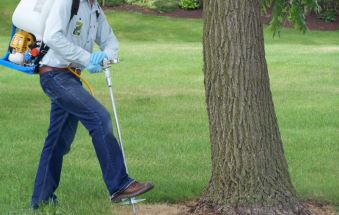
Soil injection. Trees Winnepeg

Soil Drench Method. Mills Tree Health Care
With the soil drench method you simply pour chemical mixed in water on the soil near the tree’s root crown. Mulch or other surface organic matter is pulled back and the chemical is poured directly on mineral soil. Then the mulch is replaced. The amount of chemical used is based on inches of trunk diameter and will be stated on the label. Chemicals used would be similar to the soil injection method.
With soil injection and drench methods the trees are not wounded but presumably somewhat higher amounts of chemicals must be used than with injection (though maybe less than with spraying) and there is more possibility for affecting non-target insects. The soil drench method uses almost no tools. Uptake may be slower than with trunk injection, and it is even more important that the chemical be water soluble.
Trunk Basal Spray
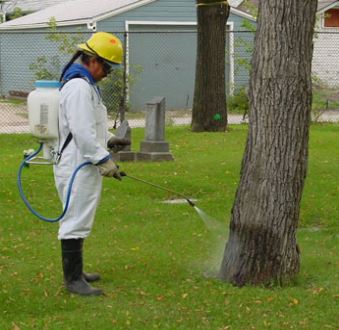
Trunk Basal Spray
Trunk basal sprays involve spraying, but instead of the chemical being applied where it is needed, it is applied to the trunk base and is absorbed through the bark and then taken up in the vascular system. Techniques vary, but basically you spray a chemical on the lower five feet of a dry trunk, saturating the bark. A low pressure spray can be used to minimize drift and splash. Chemical uptake occurs through bark, presumably especially through the tissues at the bottoms of the deepest bark crevices. The method is fast, equipment is simple and fairly cheap, there is little chance for spray drift, and no holes are required. Dinotefuran (Safari) is applied with this method for control of black pineleaf scale and other pests. Imidacloprid also has been applied experimentally with this method but it currently is not labeled for such use. Check what the label allows for your state before you purchase or apply a chemical. Labels regularly change so check each time you use a chemical.
Which is Best?
Deciding which of these chemical application methods is best depends on your circumstances, the tree’s circumstances, and the target pest or nutrient used. Methods that do not harm the tree, especially if they are done repeatedly, should be chosen first. Simplicity and low cost also are important. Trunk basal spray and soil drench meet those criteria, as does soil injection if the equipment is readily available.
Injection without a drilled hole (i.e. ArborSystems Wedgle Direct-Inject system) seems attractive at first glance, but equipment is expensive and, more importantly, the bubbles or embolisms forming during the injection can cause significant wounding. A paper presented at a symposium on hemlock woolly adelgid control (Smith and Lewis 2005) described and showed photographs of considerable dieback associated with both the ArborSystems and Arborjet injection systems used for imidacloprid injection. Given those results the use of injectors that produce enough pressure to lift the bark, with or without a drilled hole, must be done with caution. If other methods are available they should get priority. Repeated treatments (e.g. yearly) with these methods should be avoided.
Injection and implantation probably is most useful where soil access is limited or extensive root damage may have occurred. Even then, a trunk basal spray would likely work, assuming the product is labeled for the pest and for that type of application.
Caution
Use of trade names and specific product examples is not meant to imply endorsement of certain products. Always read pesticide labels and follow directions.
Resources
- USU Extension Forestry Website
- Harrell, M. 2007. Chapter 5 – Tree injections and implants. In: IPM of Midwest Landscapes: Tactics and Tools for IPM Website; pp. 32-34.
- Helson, B.V., D.B. Lyons, K.W. Wanner, and T.A. Scarr. 2001. Control of conifer defoliators with neem-based systemic bioinsecticides using a novel injection device. Canadian Entomologist 133(5):729-744.
- James, R., N. Tisserat, and T. Todd. 2006. Prevention of pine wilt of Scots pine (Pinus sylvestris) with systemic abamectin Injections. Arboriculture & Urban Forestry 32(5):195-201.
- Shetlar, D.J., and D. Herms. Date Unknown. MicroInjection of Systemic Insecticides Into Trees.
- Smith, K.T., and P.A. Lewis. 2005. Potential concerns for tree wound response from stem injection. In: Proc. 3rd Symp. on Hemlock Woolly Adelgid, pp. 173-178.
Published December 2011.

